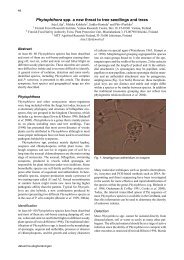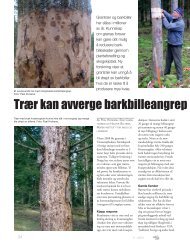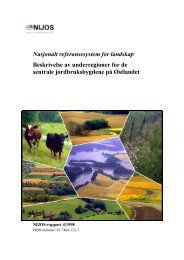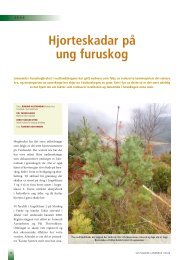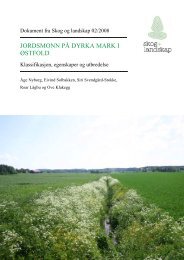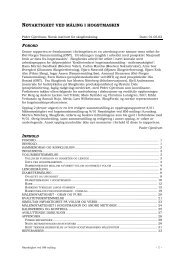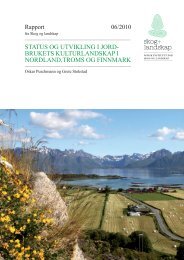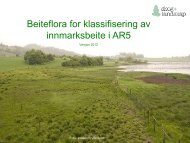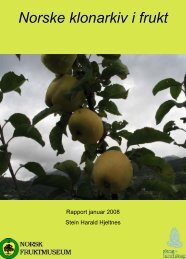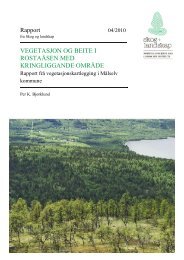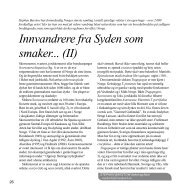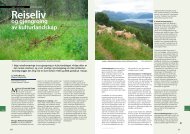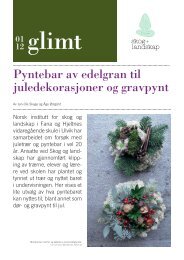Download pdf - Skog og landskap
Download pdf - Skog og landskap
Download pdf - Skog og landskap
Create successful ePaper yourself
Turn your PDF publications into a flip-book with our unique Google optimized e-Paper software.
current study we removed the GUS reporter gene<br />
from pCW122 to reduce the size of the pCW122<br />
(8174 bp) and thereby ease the transformation into E.<br />
coli. Even without uidA pCW122 was fairly large<br />
(6273 bp) increasing to 7641 bp after insertion of<br />
PSS1. We now consider the removal of uidA a<br />
mistake. Knowing the difficulties met to screen for<br />
the presence of nptII, and the problems to interpret the<br />
test results, a simple stain for β-galactosidase activity<br />
to indicate the presence of non-transgenic (or<br />
silenced) tissue would have been very useful.<br />
Despite the problems met during PCR-testing, a<br />
comparison of DNA analysis test results obtained at<br />
KVL and at <strong>Sk<strong>og</strong></strong>forsk makes it very unlikely that no<br />
transgenic embry<strong>og</strong>enic lines of Norway spruce has<br />
been produced. PCR-results at KVL and at <strong>Sk<strong>og</strong></strong>forsk<br />
for the cell line 11703-B63 support each other, and<br />
suggest that several transgenic lines of the types K1<br />
and K4 have been produced. These lines are marked<br />
with a‘*’ in Table 2. Unfortunately, few of these seem<br />
to produce the NptII protein. Embry<strong>og</strong>enic lines<br />
produced after bombardment of the cell line 186-3C<br />
were found to be transgenic only at <strong>Sk<strong>og</strong></strong>forsk,<br />
leaving uncertainty about these results. The lines were<br />
tested to be transgenic for nptII, and may also be<br />
transgenic for the pinosylvin synthase gene PSS1 as<br />
this gene is carried on the same vector. A test for<br />
PSS1 is needed to prove this. Suitable primers would<br />
amplify an 805 bp band from non-transformed Scots<br />
pine, whereas no bands should be detected from nontransformed<br />
Norway spruce.<br />
Fifty Norway spruce seedlings were produced<br />
successfully from the cell line 11703-B63,<br />
transformed with plasmids carrying pinosylvin<br />
synthase both in sense and anti-sense directions. The<br />
cell line 186-3C proved more difficult to regenerate<br />
plants from and only 3 seedlings were produced. The<br />
seedlings had a normal appearance. Unfortunately<br />
they died during cold storage before any testing of the<br />
plants had been carried out.<br />
The authors believe the transformation technique<br />
applied needs improvement, before further<br />
regeneration of transgenic seedlings is worthwhile. A<br />
transformation system where only single cells instead<br />
of cell aggregated are bombarded with plasmid would<br />
eliminate the possibility of non-transgenic escapes,<br />
especially in combination with high efficient selection<br />
techniques.<br />
No results about the effect of modified stilbene<br />
production in Norway spruce on spruce path<strong>og</strong>ens<br />
could be obtained from this study.<br />
References<br />
Brignolas, F., Lieutier, F., Sauvard, D., Yart, A.,<br />
Drouet, A. and Claudot, A. C. 1995a. Changes in<br />
soluble phenol content of Norway spruce (Picea<br />
abies) phloem in response to wounding and<br />
inoculation with Ophiostoma polonicum. European<br />
journal of forest pathol<strong>og</strong>y 25: 253-265.<br />
Brignolas, F., Lacroix, B., Lieutier, F., Sauvard, D.,<br />
Drouet, A., Claudot, A.-C., Yart, A., Berryman A. A.<br />
and Christiansen, E. 1995b. Induced responses in<br />
phenolic metabolism in two Norway spruce clones<br />
after wounding and inoculation with Ophiostoma<br />
polonicum, a bark beetle-associated fungus. Plant<br />
Physiol<strong>og</strong>y 109: 821-827.<br />
Celimene, C. C., Micales, J. A., Ferge, L., Young, R.<br />
A. 1999. Efficacy of pinosylvins against white-rot and<br />
brown-rot fungi. Holzforschung 53(5): 491-497.<br />
Chiron, H., Drouet, A., Lieutier, F., Payer, H. D.,<br />
Ernst, D. and Sandermann, H. 2000. Gene induction<br />
of stilbene biosynthesis in Scots pine in response to<br />
ozone treatment, wounding, and fungal infection.<br />
Plant physiol<strong>og</strong>y 124(2): 865-872.<br />
Clapham, D., Demel, P., Elfstrand, M., Koop, H.-U.,<br />
Sabala, I. and von Arnold, S. 2000. Gene transfer by<br />
13



